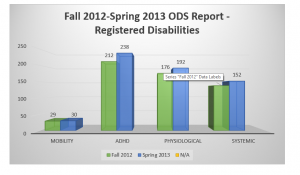
Many people may associate the month of October with LGBTQ history and Breast Cancer Awareness, but it is also a month dedicated to Disability Awareness.
The Office of Disability Services released two reports at the end of the fall semester 2012 and spring semester 2013 after acquiring student feedback, detailing the need for more resources for students with physical disabilities.
An anonymous comment, submitted that fall, reported that wheelchair accessibility at the ODS seemed difficult:
“The location of the office is pretty good, though I am not sure how easy it is to access by wheelchair. I do wish the office could be a little larger.”
In addition, the report listed 29 physically disabled students registered at the ODS in 2012 and an overall majority of students as having attention deficit and hyperactivity disorders, physiological disorders and systemic or chronic medical conditions, such as diabetes.
Results in the spring semester also presented data showing that there were dominant groups of students with different disabilities registered within the ODS and that changes based on student feedback needed to be made.
Some of the changes made by the ODS included an automatic door being placed at the front of the main office, as well as for their testing and computer rooms, placing new motivational pictures in testing rooms and reception areas and bells and signage in the reception area.
Other changes included modifying testing environments by installing pipes and draping to create individual testing cubicles for students to take final exams. Additionally, the Student Accommodation Letter was updated to ensure faculty and ODS staff names were in print on the letter, as well as the corresponding course, semester and year.
But did these changes really satisfy
the needs of students with physical disabilities?
Lanier Henson, Student Government Association (SGA) vice president of student affairs said SGA is working on new initiatives the university may
have missed, like easier access for disabled students trying to use the
Panther Express shuttles.
“Last Friday during a Mandatory Fee Committee meeting, the student government voted on reallocation of previous funds used to pay off a loan for the bridge between Library North and [Library] South to go towards transportation and parking,” he said. “Part of the proposal included funds to purchase a new fleet of Panther Express buses. These new buses will have improved accessibility for persons, and will board and depart at street level.”
Another issue with accessibility that has been brought to Lanier’s attention multiple times is the stairway(s) on the street from Courtland St. down to the courtyard, right outside the library, that have no wheelchair ramps or ramp system.
Without a ramp system available in that area, students and faculty members with physical disabilities are forced to travel farther than most students when trying to find an automatic door and sometimes end up not entering the courtyard at all.
Henson also said that because the ODS wants to help students based on their own individual needs and special circumstances, SGA will take a slightly different stance by representing disabled students on a broader level.
“[The SGA] will act as a liaison to the upper administration that just simply can’t have the one-on-one contact with these students.”
Henson said that William Stanford, the SGA vice president of academic affairs, has been trying to help students with disabilities utilize more of the resources available to them, such as the testing center, the Margaret A. Staton Scholarship and the Bennett A. Brown Scholarship.
The Margaret A. Staton Scholarship is awarded to students who have a documented physical disability and are registered with the ODS at the university. Students must have previously completed at least one full semester of courses to be eligible.
For the Bennett A. Brown Scholarship, students must have a documented language-based learning disability, and it must substantially limit the individual’s ability to read, write or comprehend spoken language.
Universities across the nation are also dealing with new ways to help students with physical disabilities and many universities are offering state-of-the-art special services and programs for students with mobility disorders, According to http://education.com.
Some of these universities, like the University of Illinois Urbana-Champaign, which was ranked number one for students with physical disabilities to attend, created the first wheelchair-accessible bus system and competitive wheelchair sports program.
Dayton, Ohio’s Wright State University, ranked number three on the website, has a system of underground tunnels connecting buildings together so students with mobility disorders don’t have to travel outside in extreme weather conditions.
The University of California-Berkelery offers
students the ability to find personal attendants and accessible housing.
In an effort to discuss the ways in which the university, faculty and students can help raise disability awareness, the ODS at Georgia State University held its first ever BlazeDay event On Oct. 22, in the recreation center.
“The purpose of this event is to raise awareness of the range of sports available to people with physical disabilities, to educate students about the different types of physical disabilities, encourage inclusion of students with disabilities and to help educators become more knowledgeable of the importance of active lifestyles for students with disabilities,” Pamela Pressely of the ODS said.
The BlazeDay event included sitting volleyball, wheelchair relays and Boccia.
The activities at the event were designed to show all students, not just those with physical disabilities, that everyone can participate.
Pressely also stated that she hoped BlazeDay would be a success so that the office can continue hosting it each year in October.

